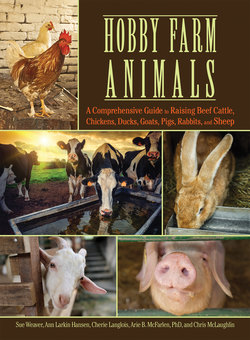Читать книгу Hobby Farm Animals - Chris McLaughlin - Страница 22
На сайте Литреса книга снята с продажи.
How to Tell When an Animal Is Sick
ОглавлениеYou can’t identify a sick animal until you know how a healthy animal looks and behaves. That’s why it’s important to spend time on a routine basis just watching your herd. Become familiar with how your cows walk, lie down, get up, chew their cud, lick themselves, stretch, scratch, push each other around, and take care of their calves. This can be a delightful task. When our cows are in the paddock next to the house, there’s nothing more pleasant than taking a cup of coffee out onto the deck and watching them. Summer evenings are especially nice, when it cools off and the calves get frisky. They’ll race around the cows, butt heads, and buck. And sometimes the cows even come over and watch us.
Once you know what’s normal for your cattle, you’ll be better able to spot abnormal behavior or appearance. If you get into the habit of regularly taking a good look at each animal, you’ll catch problems early. Early diagnosis and treatment is half the battle when it comes to curing a sick or injured animal. A cow that goes off by itself and is not grazing with the others is reason for concern. A cow that is not chewing its cud, spends an abnormal amount of time lying down, has inflamed eyes, shows no interest in its surroundings, or moves only with effort should be examined more closely. A cow that kicks at its belly, stands still with its back arched, has watery diarrhea, or looks like it’s been pumped up with an air compressor needs immediate attention. A calf with labored breathing should also be examined immediately.
